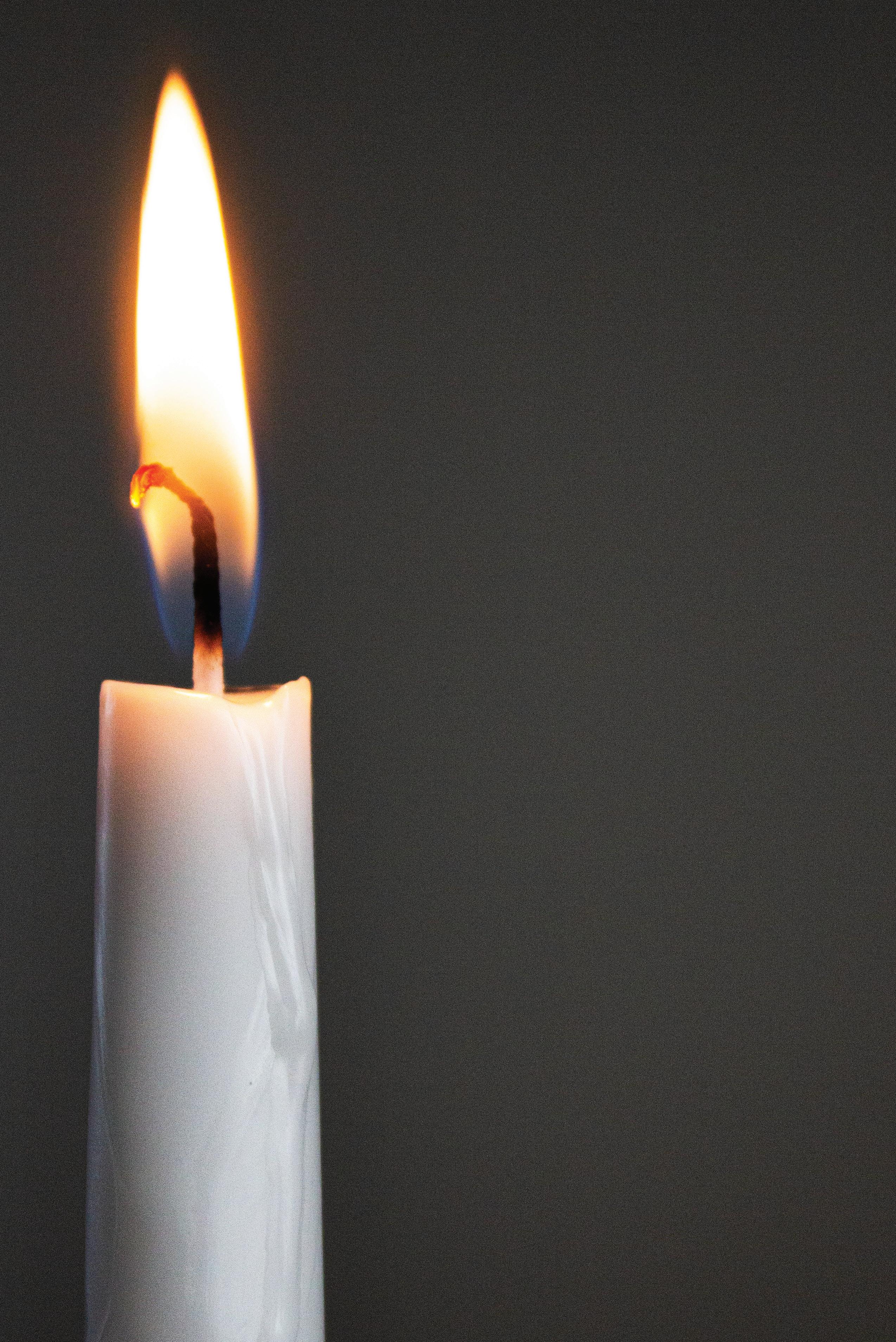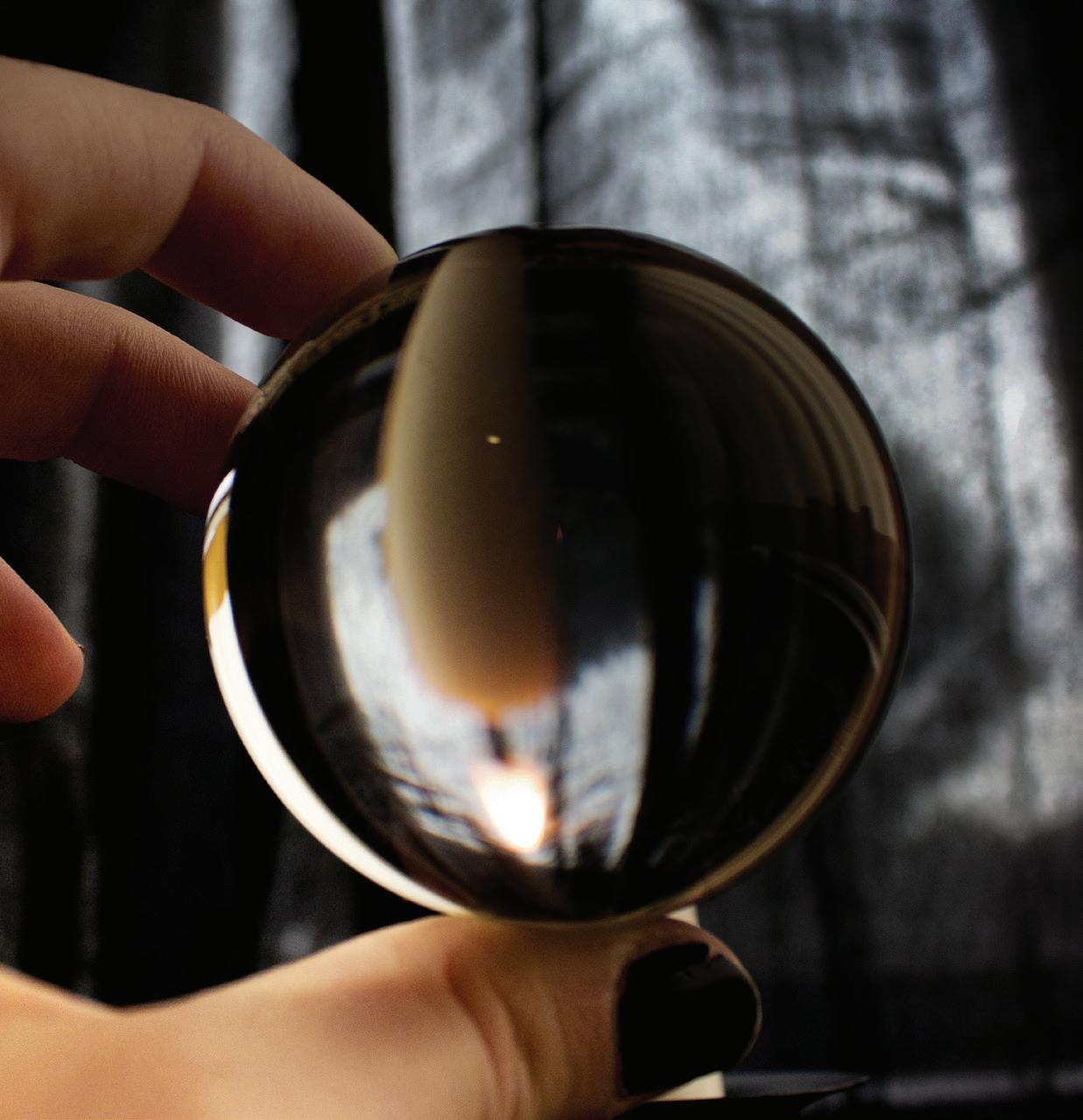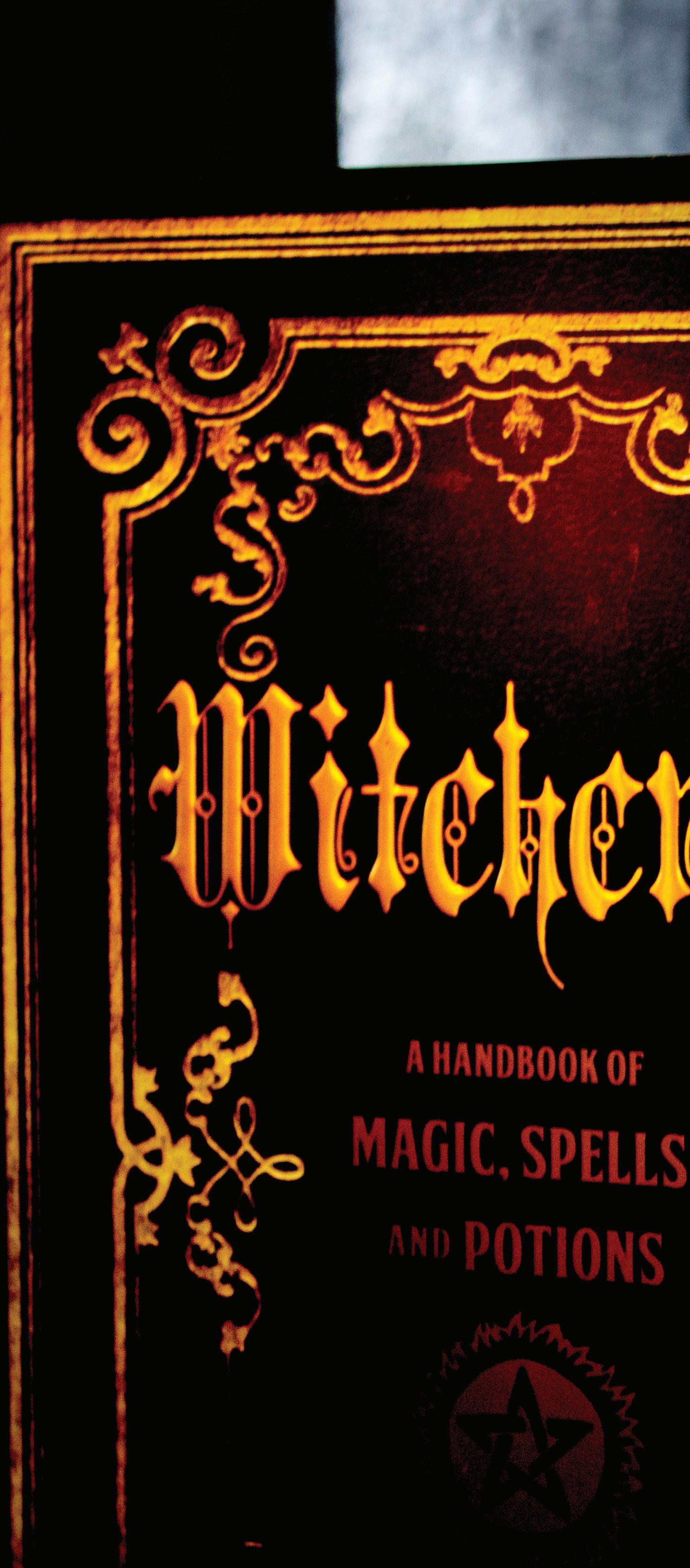
7 minute read
The Witching Hour
The Witching
HOUR
Advertisement
Story by Kiersten Kimminau Photos by Kassandra Eller Design by Kayla Craig
What is a witch? Is it someone who casts spells and makes complex potions using bizarre ingredients? Is it a cloaked figure wearing a tall pointy hat and flying a broomstick? Maybe it’s a mysterious gypsy who waves their hands over a crystal ball, claiming to know your future. Or perhaps a witch is none of these things.
The stereotypical witch makes for a fun costume and spooky television show concept, but the modern witch may actually be nothing like the embellished images you’ve seen before.
Here is what some real witches have to say about their practice and experiences with magical living.
Witchy Beginnings
Witchcraft can mean a variety of things to different people, but most who practice could agree that it has touched their lives in a very special way.
Kate Garret, witch and magical editor of Mookychick, a website that describes itself as a community for alternative feminists says even before she started officially studying magic, she felt called to the practices of witchcraft. She adds she was surprised to find that everyday rituals and practices she engaged in were actually witchcraft.
At the age of 16, Garret explains she began to officially study magic, occult practices and other religions. Before long, she says she started casting spells and performing her own rituals and later, at the age of 17, she began to study Astrology and Tarot.
Witchcraft can often be an outlet for connecting with one’s deeper self to find more clarity in life.
Kaela Hogan, senior Performance Theatre Arts major and Astrology and Tarot investigator, explains Tarot’s main purpose is to serve as “a guide and also as a reflection.”
Lexico, a dictionary powered by Oxford University, defines Tarot as “playing cards, traditionally a pack of 78 with five suits, used for fortune-telling … The suits are typically swords, cups, coins (or pentacles), batons (or wands) and a permanent suit of trump.”
Hogan expresses that reading Tarot helps her introspect about the way she is feeling and what her needs may be. This practice of introspection and finding outlets to think through various situations in life seems to be a cornerstone of witchcraft.
Garret confirms that witchcraft has become an extremely impactful foundation in her life.
“It’s helped me to embrace motherhood, overcome huge amounts of trauma, accept and learn to live with premenstrual dysphoric disorder and other chronic conditions and to even become a better poet,” she says.
Spells, rituals and cosmic readings are not necessarily solutions for everything though. Garret explains, “Sometimes the most magical thing you can do is learn to ride big waves until the sea calms.”

Spells, Faith and Religion, Oh My!
Every witch is different, and they most certainly do not all worship the devil, contrary to what popular television shows like “Chilling Adventures of Sabrina” may make you think.
Garret explains, “There are Christian witches, pagan witches, satanic witches, atheist witches and plenty of others, because witchcraft on its own is a practice and a craft, not a religion.”
Marissa Bonner, junior Elementary Education major, became interested in witchcraft around the age of 12 after initially being introduced by her sister. Summers spent with her aunt, who practices Tarot reading, further sparked Bonner’s curiosity, she says.
She adds that it was not until her sophomore year of college that she began to practice and explore witchcraft on her own. Bonner explains that one way she incorporates magic into her everyday life is by finding simple spells to try and remedy everyday problems, such as finding a missing object for herselfor friends.
In addition to spell casting, Bonner inc porates her Christian faith into her magical practices as well. “A lot of people think that it’s sacrilegious or that it’s evil or demonic,” but shesays, “Every time I sit down and I read the Bible or I’m writing a Bible verse or trying to interpret it, most of the time it’s about self-discovery.”
There may be different interpretations of Christianity and witchcraft depending on who you ask, but for Bonner, both combine to help her to live a happier and healthier life.
It is elements of self-discovery as well as biblical messages of positivity and encouragement that Bonner feels intertwine with her practice of witchcraft.
Although Bonner maintains her Christian faith and practice of witchcraft, there are others who are influenced differently by religion.
Hogan explains she attended Catholic school for years and grew up under the authority of various institutions, but always knew she was a witch from a young age. Although she does not consider herself Catholic, spirituality has still played a role in her personal growth today.
She explains, “I needed to go through life and check out other spiritualities and other religions before really coming to find that I think witchcraft is the perfect fit for me on a spiritual, religious and … individual-growth kind of level.”
Respecting History
Now you know that truly anyone can be a witch. But there is still a lot of history to knowabout witchcraft and spiritual practice.
Hogan offers a lesson for witches and non-witches alike. “I think there is a lot of disrespect being given to indigenous cultures who have not had the chance to practice their own spirituality,” she says.
Unlike many others throughout history, Hogan notes that as a white individual, “I have the ability to identify as a witch and not face any dangerous repercussions and that is a privilege… I want everyone to be able to have that,” she says.
Hogan notes that many cultures and communities have been oppressed for wanting to practice their faith. She refers to the American Indian Religious Freedom Act of 1978, created to protect the religious rights and cultural practices of American Indians and other Native citizens.
Modern witches have the privilege of being able to practice openly however they want. Hogan hopes people can acknowledge and use this privilege to practice their craft respectfully.
Take white sage as another example; an herb commonly used in healing and cleansing rituals.
Hogan encourages witches to be respectful towards Native cultures who rely on the herb as well as the environment in which sage is becoming endangered.

Hogan offers a tip to be money savvy, environmentally and culturally conscious. “Here in Ellensburg, we have a ton of sagebrush … people can make their own sage sticks,” she says. Any responsible and respectful witch can do their research and collect herbs — sage included — to meet all their witchy needs.
Hogan urges people to do their research and be respectful. So there you have it: your next witchy lesson is that witches, magical though they may be, are not immune to the various issues that affect our culture.
Modern Magic
Hopefully by now you have realized that anyone can be a witch regardless of how they grew up or what they believe. Quoting “Practical Magic”, a witchcraft movie from the 90s,
Garret says, “I do think ‘there’s a little witch in all of us’. It does take time and practice and willpower and a willingness to learn and study, but there’s a style of magic to suit all people who truly feel called to this path.”
Access the inner witch in you by starting small. “A lot of people believe that if you're going to be into witchcraft, you have to dive completely in and you have to go full force … I’m not like that,” says Bonner.
Bonner recommends doing your own research and taking time to learn about what magic resonates most with you. “I feel like this new wave [of witchcraft] is more about integrating it with your life and making you a better person in the process,” she says.
Summer looms near and you may not have much to do. If you’ve felt called to witchcraft, or even just a little bit curious, now may be the perfect time to explore that interest further.
Referring to solitary days in quarantine, Hogan says, “I really hope that this time of forced introspection gives ways for people to connect back to their psyche.”
Now that your days are likely filled with nothing but time, Garret recommends, “Focus on an activity that makes your heart happy … and feel the joy and uplift it brings into your life.
Notice how it changes you. This is a tiny bit of magic — an action that brings about an obvious change.”












